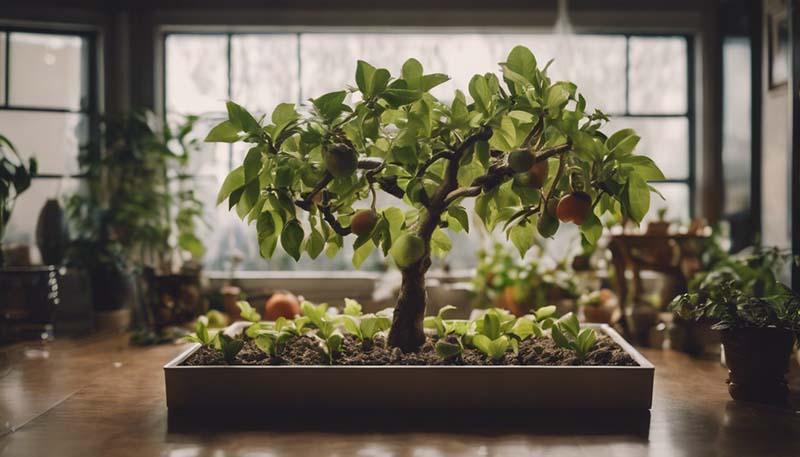Growing an indoor fruit tree can be an incredibly rewarding experience, transforming your home into a lush, fruitful space. With the right care and attention, you can enjoy the taste of homegrown fruit year-round. Here\'s a comprehensive guide to help you get started on your indoor fruit tree journey.
Introduction to Indoor Fruit Trees
Before diving into the specifics, let\'s understand why growing fruit trees indoors is not only possible but also beneficial. Indoor fruit trees can offer a sense of connection to nature, improve air quality, and provide a delightful hobby that can be educational for the whole family.
Advertisement
Choosing the Right Tree
# 1. Consider Your Space
Indoor fruit trees need space to grow, so consider the size of your home and the area where you plan to place the tree. Dwarf varieties are ideal for indoor growing as they have been specifically bred to remain small.
# 2. Light Requirements
Different fruit trees have varying light requirements. Citrus trees, for example, thrive in bright, indirect light, while apple and pear trees may need a period of dormancy in a cooler, darker place to produce fruit.
# 3. Climate Tolerance
Choose trees that can tolerate your home\'s climate, including temperature and humidity levels. Some trees prefer a more humid environment, which can be easier to achieve indoors.
# 4. Fruit Selection
Select the type of fruit you want to grow based on taste preference and the tree\'s compatibility with your indoor environment. Citrus, lemon, lime, and avocado trees are popular choices for indoor growing.
Setting Up the Environment
# 1. Pot and Soil
Use a large pot with good drainage to prevent waterlogging. The soil should be well-draining and rich in organic matter. A mix designed for fruit trees or a general-purpose potting mix can be used.
# 2. Temperature and Humidity
Maintain a consistent temperature suitable for your chosen tree. Use a humidifier if necessary to achieve the required humidity levels, especially for tropical fruit trees.
# 3. Light
Ensure your tree gets the right amount of light. Position it near a south-facing window for the most light. Alternatively, use grow lights to supplement natural light, especially during winter months.
Caring for Your Indoor Fruit Tree
# 1. Watering
Water your tree when the top inch of soil feels dry to the touch. Be careful not to overwater, as this can lead to root rot.

# 2. Fertilizing
Use a balanced fertilizer to provide the necessary nutrients. Follow the package instructions for the correct application rates and frequency.
# 3. Pruning
Prune your tree to maintain its shape and encourage fruit production. Remove dead or diseased branches and trim back any overly vigorous growth.
# 4. Pest Control
Inspect your tree regularly for signs of pests. Use organic pest control methods whenever possible to avoid harming your tree or the environment.
Common Indoor Fruit Trees and Their Care
# Citrus Trees
- Place near a bright window with indirect sunlight.
- Keep the soil slightly damp but not waterlogged.
- Fertilize with a citrus-specific fertilizer.
# Avocado Trees
- Require a well-drained soil mix.
- Prefer bright light but can tolerate some shade.
- Water deeply and less frequently.
# Apple and Pear Trees
- Require a cooler, darker period to encourage fruiting (known as vernalization).
- Prune to maintain a compact size suitable for indoors.
- Provide a balanced fertilizer in the growing season.
Troubleshooting Common Problems
# 1. Leaf Drop
This can be due to rapid changes in temperature, overwatering, or underwatering. Adjust your care routine accordingly.
# 2. Yellowing Leaves
This may indicate overwatering, underwatering, or a lack of nutrients. Check the watering schedule and consider adding a balanced fertilizer.
# 3. No Fruit Production
Ensure your tree is getting the right amount of light and is not too young to fruit. Some trees may also require a pollinator, so consider getting a second tree for successful fruiting.
Reaping the Rewards
With patience and proper care, you\'ll be able to enjoy the fruits of your labor, quite literally. Harvesting fruit from your indoor tree can be a delightful experience. Use a gentle approach to avoid damaging the tree, and enjoy the fresh, homegrown produce.
Conclusion
Growing an indoor fruit tree is an ambitious but achievable endeavor. By selecting the right tree for your conditions, providing the proper environment, and caring for your tree with attention to its specific needs, you can enjoy the benefits of a fruitful indoor garden. It\'s a project that not only beautifies your living space but also connects you to the process of growing and nurturing life.
Comment